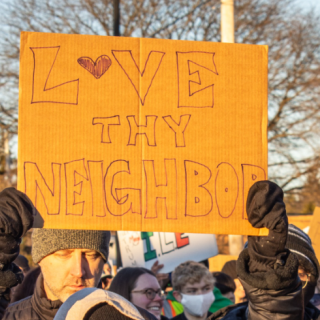Advertisement
Gloria Steinem and Madeleine Albright scolded young women for supporting Bernie Sanders instead of Hillary Clinton before the 2016 presidential primary. They implied that in supporting a candidate based on politics instead of gender, millennials are either ignorant or complacent about the feminist struggle.
On March 8, the International Women’s Day celebration on the Ohio State campus revealed just the opposite. Many of the young women, men, and non-cisgender people who gathered on the Oval had just come from a 1,000-strong solidarity teach-in organized by Columbus Coalition for International Women’s Day. Most were far more in touch with the radical foundations of the women’s movement than its most recognized “icons” are.
“I’m a Marxist feminist, like Angela Davis and Rosa Luxemburg,” said Emily Shaw of the International Socialist Organization.
“We all are struggling under capitalism,” said Kira Wedin of Socialist Alternative. “We’re all facing Donald Trump and his creeping fascism. Instead, I want to talk about the Russian Revolution.
“100 years ago today, on March 8, women textile workers in St. Petersburg, Russia went on strike and toppled the Tsar,” Wedin said. “As they took to the streets, they called out to the men and women in the factories, bringing tens of thousands of people into the streets. Increasing clashes between the Tsarist forces and the revolutionary forces led to the abdication of the Tsar, the institution of the soviets, which were councils of workers, and the creation of a provisional government, which were a bunch of unelected, elite liberals who were eventually forced out, ceding power to the soviets in the October Revolution.”
Since when is women’s liberation discussed in the context of socialist revolution? Angela Davis and others have done this for decades, but it’s been happening more since millennials — who didn’t grow up under the influence of Cold War propaganda — have done their homework and realized that socialism and feminism have always been part of the same struggle.
In 1909 Socialist Party of America organized the first Women’s Day celebration in New York City. In 1917 the Soviet Union declared March 8 a national holiday to commemorate the women’s strike that launched the Russian Revolution. International Women’s Day was celebrated mainly by communist countries and the socialist movement until the United Nations adopted it in 1975.
Before it degenerated under Stalin, the workers’ state in Russia was one of the most progressive governments in modern history. Women were given the right to vote, and equal access to education and health care. It was also the first government in the world to strike out all laws discriminating against LGBTQ people and consensual sexual activity.
Gloria Steinem’s work for a CIA front organization in the 1960s is a matter of public record, but it’s seldom mentioned in the mainstream media. A censored section of the Redstockings book Feminist Revolution “details the right wing corporate funding which helped Steinem inaugurate Ms Magazine, as well as the magazine’s pivotal role in transforming American feminism from a broad multi-class, multiracial movement to one devoted to divisive male bashing and advancing career opportunities for white upper middle class women,” Dr. Stuart Jeanne Bramhall writes.
Since Steinem came to prominence there have been two strands of feminism in the United States. Steinem’s version emphasizes individual empowerment: women climbing the corporate ladder and achieving high political office. Steinem’s brand is favored by corporate America and the 1 percent because it keeps existing power structures intact.
The original strand of American feminism, best represented by Angela Davis, emphasizes the collective empowerment of all women within an oppressive capitalist system that needs to be abolished and replaced.



